Text
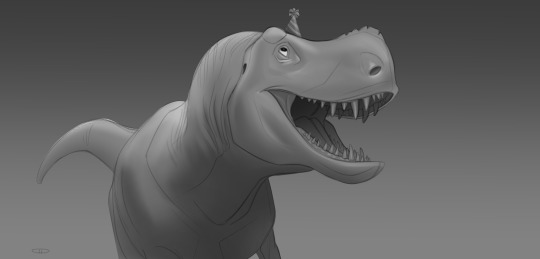
Now that I've turned 30 I have become a real dinosaur.
257 notes
·
View notes
Text
Birthday Oviraptor
birthday gift i made for @/Philoceratops on twitter a while ago
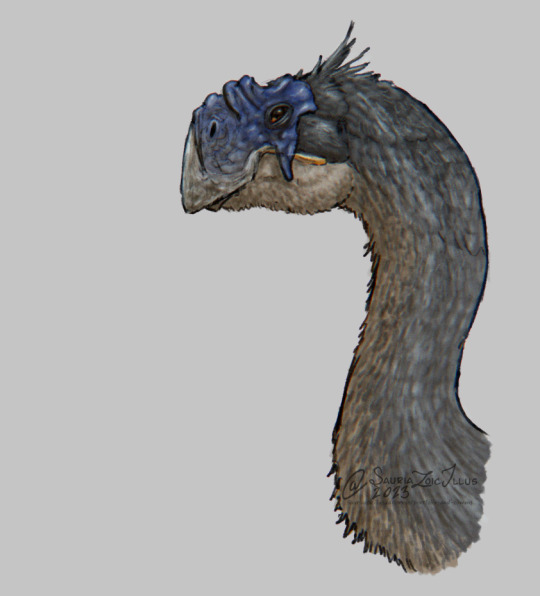
74 notes
·
View notes
Text
Spectember D30: Your favorite spec critter!

I guess when it comes to plausibility this animal from its world settling to its anatomy and physics might have aged terrible for many people, but I genuinely have a lot of appreciation for the Megasquid, since I was young and watched the TFIW series, this was one of the things that made me interested in spec evo in the first place (unitl I watched Dragons a fantasy made real) when I was young with interests for the peculiarity of its design and behavior, the idea that earth wouldn’t be only so alien but also animals would turn totally apart of what they were their ancestors, a walking behemoth elephantine squid that is the largest terrestrial animal of its time.
100 notes
·
View notes
Text
Flocking Paleostream 9/22/2023
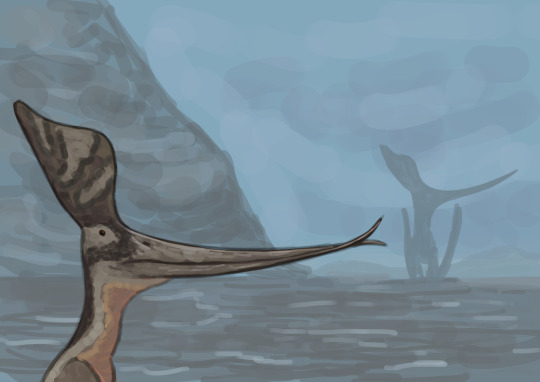



Another Friday, another batch of silly little fellas I must very quickly draw in about 20 minutes each for the week's #paleostream and they are, as always, deeply and sincerely unserious. Featuring Geosternbergia, Archocyrtus, Titanophoneus, and Besanosaurus. Very blue today.
222 notes
·
View notes
Text

Repostober #2, this piece from uni! Watercolors on.... cold press? I think?
Still one of my faves.
72 notes
·
View notes
Text
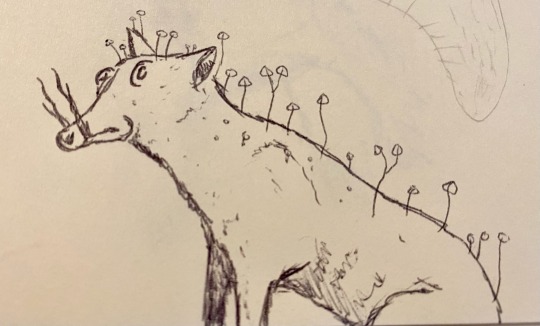
super rough sketch of a character from one of the Beetle Souls novels, an albino mouse-deer woodwitch who’s spent a few too many hours hooked up to the mycelial earthminds
20 notes
·
View notes
Text
Spectember D29: Speculative Biome

Is not an oddity for geologists to look at some strange landscape formations, many caused by singular events or just by erosion, but the most particularly perplexing ones have been made by what is not considered to be a thing from this world...
North America seems to be dotted with dozens of these structures and the remains of already fallen ones, looking like gigantic towers of more than a kilometer in height, structured like a strange tree shaped form, it rises like a testament of the biggest terrestrial organism known, a monster tree made of stone and shaped by the millions of years of constant growth by part of a singular organism.
In Wyoming there is the most intact and oldest specimen of such beings, bein nicknamed Heaven’s Tower, unique megaorganisms formed by thousands of individual slime like organisms that behave like a stromatolite as it accumulate over layers over layers of sediment and material it built its structure, the way it do it seems to comprehend a system of vessels that transport the material from the terrain, often hollowing the terrain below forming a large cave chamber system that accumulate water and organic matter, preserve itself from erosion protected by a microbial layer product of the same organism. The tower seems to often renovate itself by the use of a special slime covering every century based on studies of change of texture and viscosity in the tower surface, but from what accounts on different expeditions into the inner cave system denote that the whole Tower formed dozens of millions of years ago, from mining expeditions around the chamber as well drilling in the main structure it was found it preserved a decent amount of data in the form of layers created by the accumulation of minerals by the slime into the main structure like a terrestrial stromatolite, this giving a possible date of the formation of the original tree around the late Eocene or early Oligocene.
As well seems to be every 5 to 10 million years there is a process that allow the introduction of surface fauna that always ends up into the lower chamber, to be eventually isolated which seems to last for few million years until there is a occurring a total extinction of the inner fauna, caused by the replacement and collapse of a old layer as its being replaced by a new one of almost 20 m of thickness, so far from fossil record the last breach occurred around the late Pliocene, isolating the fauna that lived upon that time.
The way one of the Heaven’s Tower specimen grow or originate is pretty much unknown for the very long span of time it takes to even start forming, is believe one of these might find a specific and rich place to feed its structure, more or less an old volcanic region and slowly accumulate to form the megastructure that feed symbiotically by chemosynthesis from the igneous rocks and photosynthesis, as well there has been identified fossil remains of older already fallen Towers that also expose similar patterns of growing. The Heaven’s Tower of Wyoming is the last intact structure as many seems to have been destroyed by the last ice age, and will take millions of years to recover, this itself is a testament of a paradoxical being that is still investigated, as this being for many accounts seems to not share any significant relationship of any living organisms.
276 notes
·
View notes
Text
Spectember D28: Spec at the Cell level

Is not strange for space traveling ships to find unusual concentrations of biological matter around some solar systems, probably expelled from some icy moon or from asteroids that are disintegrating, through a unique case happened through the investigation of a crumbling space super structure, upon reaching a space station the ship used for the travel showed a considerable damage in the side of the isolation panels, which was covered by a dark slime-like goo that for the time passed from the exploration of the ruins to reaching a space station it was noticeable it grew up on the surface as originally were spotted as small dot that partially were clean, and even managed to corrode the surface making it a hazard to be checked out before it could spread to other gear.
What was found out was something more peculiar than a strange corrosive element and more of an organism thriving of feeding of artificial parts of the remains of the super structure, nicknamed the Cecisolus, as far it was analyzed this was a mat colony made of thousands of eukaryote like organisms with a simple nuclei and different organelles, through over it there was a second layer of the body membrane which on one section was concentrated few more layers of dead tissue reinforced with Melanin in high quantity, within them there were multiple chains of chemical connections that integrated within some organelles which in reaction to sunlight radiation produce a reaction that is converted to energy and the Melanin reflect the rest to avoid any mutation of the cell, as the energy is transferred the organism proceed to digest the artificial spaceship material into molecules useful for their survival, disposing of the rest into space or out of the cell in the form of a dark soot.
The process seems to take days and even days to happen, probably for the energy that takes to break the compounds. In a second expedition in the remains ancient super structure it was found more colonial mats great quantities, specially around of what was identified as electricity or energy conducts and infrastructure. There has been some speculation of such correlation that the mats was once part of a organic technological system created by the extinct civilization artificers of the megastructure millions of years ago, a system that collected the solar energy of the star like solar panels and regenerated itself by feeding it specific chemicals, but on some point after abandoning the super structure the photonic collector organism might have suffered of some mutations upon a failure of their facility or a disastrous event, spreading and likely devouring the space artifact, which many researchers are considering the main reason why this ancient space habitat became a total ruin.
28 notes
·
View notes
Text
Spectember D27: Revamp the Dinosauroid

The end of the Triassic propitiated finally the dominance of dinosaurs in the next period with the rupture of the large supercontinent Pangea, though in this timeline something pushed further the fragmentation of the continent, and instead of just opening the rift of the Atlantic, it multiplied across Africa and a section of south America, making the Tr/J mass extinction more severe and killing out many more species of dinosaurs, so now the Jurassic was no longer dominated by the animals we have in our timeline, instead we get a strange variety of large dinosaur-like crocodiles, many sauropodomorphs that diverged from the smaller species that survived and never went into the same trend of gigantism as in our earth, many synapsids and so on.
At the end of the late Jurassic a lot happened with the new order, within some of the second radiation of sauropodomorphs included varied carnivorous carnosaur-like species, medium size coelurosaur-like omnivores and smaller herbivores that look like silesaurs; from the omnivore lineage that have expanded in varied niches would rise a branch of semiaquatic species that resembled something like a scaly penguin with hands, long finger and claws, with short robust tails, shorter necks and longer heads with narrow keratinized mouths.
They are remarkable as many other animals of this world, through one particular species seems to have started a peculiar evolutionary trend in the last 10 million years.
For the reader, we will refer to this species as the Shagoids, a species originated from 50 cm long aquatic sauropodomorph descendants that wandered on the estuaries of the now more fragmented north Africa/south American region, their ancestors were more of a mix of a cormorant with an otter as unlike the rest of its own family this belongs, as one main feature of these are they still functional forelimbs, these still preserved functional arms and hands that helped them to manipulate their prey of crustaceans and mollusks. Over time these developed strategies to break down their prey shell, including the habit of picking and using stones which choose appropriately for this task. This behavior was passed on to new generations, learned and properly helped them to get food with less effort, the food quality increased brain energy, brain size also increased and so their skills were forged much more adequately.
It was on matter of few million years the Shagoids lineage abandoned their swimming lifestyle and became mostly semi aquatic coastal dwellers, living in the shores and just entering water to hunt their food rather than spending most of their time there. As social animals they formed hierarchy groups, formed by the head of a dominant female around minor males that could either mate with her or just serve them, as well many other younger individuals, matriarchs often had the duty to select and organize hunting and spending of food, as well regulate reproduction and mating between their lower family, as she normally is the eldest of the group, and only another female of the same blood can turn into a elder matriarch of if mated by the son of the elder, this perhaps was the moment they gained proper sentience as how they defined a cultural and social structure.
It seems at the end rathe in a sudden change of sea level in the last 3 million years did the final push on their evolutionary journey, as most of the Shagoid populations got stranded within the main continent with almost no way to find new connections to large water bodies, in other situation their species would have die for starvation, but at that point they were already adapted to feed on other food sources, from tubers, insects and small animals, being able to cook them using fire they managed to craft, and so properly passed the harsh time with the loss of a chunk of their population over the sudden change.
When the Shagoid expanded and found again large water bodies far from their native regions, they really have changed considerable from their ancestors, as their closest relative was a sort of strange loon like reptilian species wandering in the coasts, these were more like limbed penguins with long arms and tridactyl hands, which the third finger being a derivation of the 4th an 5th clawless digit fused into one, their short legs lost their webbed feet a while ago and are more adapted for walking, their head still preserve the characteristic seabird like shape but their teeth have changed in shape to be generalistic omnivore, with a large head which houses the most intelligent brain in the planet.
Over the last thousands of years, they have been becoming more and more prone to establish permanent settlements populated by hundreds of them much more different of their wandering tribes, often farm plants and even carry some animals for domestication.
For the first time in their history they are in the pathway of civilization… who knows what will happen next, either the Shagoid can remain like this until their extinction, or they will start building towards the sky and beyond.
#speculative evolution#alternative evolution#triassic#jurassic#sauropodomorph#dinosauroid#sapient#spectember
34 notes
·
View notes
Text
Spectember D26: Break a biological record

Some hundreds of millions of years far into the future around 300 million years hence, after the formation of a big supercontinent, one that was not predicted to form, a lot of existing terrestrial and marine fauna look so alien compared to the animals that once man witnessed as the difference is as much as a human being would have to the first terrestrial tetrapod. Phylogenetically speaking many of those animals would be related to something like a crown, a snake, a varanid, a goby, a frog, a bat and so on but they are totally anatomically, morphologically and physiologically far from those, mammals and birds are a fraction of what they were, more mole or reptile like, varanids and frogs suffered of varied radiations and now they have been as much diverse as how dinosaurs and synapsids went through the Mesozoic and Cenozoic, and small fishes survived and radiated from freshwater species over and over from different mass extinctions, and just for matter of convergence they looked something like the modern species man saw, but they aren’t anatomically close to those.
In land mammals are just small and ectothermic creatures, in the ocean however one lineage managed to thrive as large swimmers, is not like any other group however, they have lost their forelimbs, their tails barely help them to swim and often depending of the species they have a rigid fluke or a seahorse-like prehensile tail, they managed to re-evolve some structure similarly to gills from a part of a nose cavity, a result of its proper ontogenic development as they did born not fully developed. These aren’t descendants of placentary mammals, but marsupials, a lineage that stood almost unchanged for many dozens of millions of years in the Americas and took a turn after the major calamities through the last 200 million years that drove their group to become reptile like, adopt peculiar adaptations for their lethargic metabolism and ended up in this stage, these aquatic animals were the last descendants of the opossums.
The Scorn Figoeq are a twisted form of the more seahorse-like herbivorous relatives that lives in the surfaces, living at depths of 4000 to 5000 meters under the surface is by far the deepest species of tetrapod that has ever lived, the deepest mammal to have diver so low under the ocean. It adopted the lifestyle of the already gone anglerfishes as well some other deep-water fishes, is among the last of an experimental lineage of the Figoeqs (Derivation of Figoeqqus or "shaped like horse") that tried to become pelagic planktonic feeders which ended up becoming extinct in the last 50 million years, remaining as a relic of that group. With 25 cm long, anything that could be considered mammal like only is exposed by looking at the embryo of this species as it starts with the basics of mammal anatomy, but reaching adulthood they resemble a mix of a jelly and a bizarre abyssal fish, with their short body, large head with a deep gelatinous cover that protects part of its head and eyes that now grow inside the flesh, with long dorsal spines that helps it to stabilize while swimming, their long hind flippers that look more like ray fins, and the tail that has grow a fluke to push it slowly across the darkness of the abyss.
57 notes
·
View notes
Text
Spectember D25: Ontogenetic niche shifts

Earth has recovered from a mass extinction just about 30 million years ago which would correspond to the time of the Oligocene, this version of earth happened the mass extinction of the K/Pg was delayed, so instead of ending in 66 million years ago cretaceous continued for other 30 million years until the asteroid struck down, ending the Mesozoic and so starting a new period of history of life, the delay of this mass extinction changed some aspects of evolutionary development of many groups, mammals did not became the only dominant clade in this time, many reptiles survivors have also took over, and with the short span of time that has passed to our modern times, the fauna amalgamation is a sort of reminiscence of the Eocene and even the Triassic, but cooler as the planet faced the glacial ages up to the Pleistocene.
In the ocean marine mammals are a thing of course, but they aren’t alone, Choristodere and crocodiles are also common if not predominant in the coasts and freshwater regions by a large amount, choristoderes in fact are coming in a path convergent to sauropterygians now resembling those to a big degree, with varied short body and long necked forms, predatory forms similarly to nothosaurs and very long finned forms that move across the open ocean, they have been very versatile to deal with the subsequent cooling of earth of the last 20 million years, and remain at top even with the new wave of mammals to take over the temperate and cold regions.
Among these, there are the largest coastal predators of the north hemisphere, a fully aquatic species that would look like an imitation of the Mesozoic pliosaurs, along them there are gracile fish eater forms that looks more kind to a plesiosaur, their jaws are narrower and their necks and flippers are longer, but this is no more like the juvenile of this same giant.
The Mocker Retroleviathan is a descendant of smaller choristoderes that ventured into the oceans million years before the mass extinction that already established through the extended later cretaceous thanks to the minor extinction events caused by the ecological transitions of those million years, and after the cataclysm the empty ocean left behind by the large reptiles were early claimed by these reptiles in a short time, becoming megafauna and spreading across the oceans.
The Retroleviathan is the most formidable of these, reaching up to 7 meters and weighting 2 tons, it normally feeds on different large animals including other large choristoderes, some of the piscivorous pelagic crocodilians and the increasingly large para-cetos which are derived multies that adopted fully an aquatic lifestyle resembling an archeocete with a sirenian head but with unique dentitions. They are viviparous, a female can gestate more than 10 offspring which at birth are quite independent of their parents, only being sheltered in the nearby of the territory of the adults until they reach maturity.
25 notes
·
View notes
Text
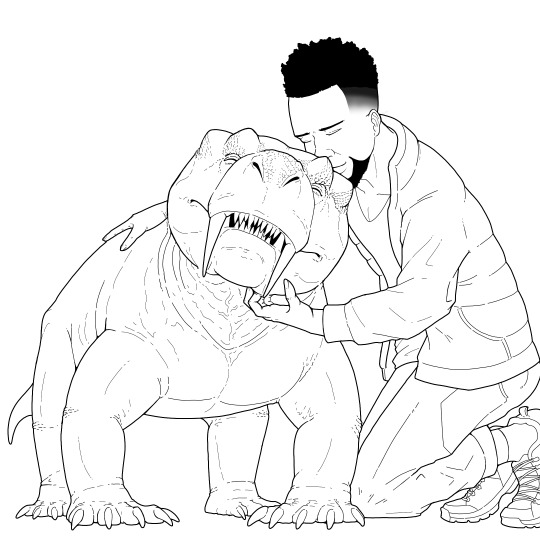
It's already october, I'm not gonna draw spooky stuffs but I'll make wholesome drawings instead, so for the first day give your gorgons some pats, smooch, and scritches.
399 notes
·
View notes
Text
Spectember Day 24: Pre-Dougal Dixon spec

Although for our current consensus how life might evolve on other planets the article has aged considerable bad in terms of plausibility, I found fascinating the article made by H.G. Wells titled "The things that live on mars” as one of the earliest attempts on speculate another ecosystem outside of our world attempting to be at least the possible conditions of Mars that was speculated could have been if it was an habitable world.
Is perhaps too simple as a spec bio exercise, but seems one of the most extensive with what was available as information could provide around early 1900 in astronomy, with nothing but our own life as a base Wells tried to explore briefly the possible biosphere arrangement that an habitable mars would be with some bases of biology and ecology, with the conditions of the planet exhibit, quasi-vertebrate lifeforms that evolved and resembled the terrestrial life on earth, quite far of the War of The Worlds Martian invaders that were octopus like form and the context these were made for the politics of the time.


#speculative evolution#exobiology#mars#alternative evolution#spectember#extraterrestrial#speculative biology
68 notes
·
View notes
Text
Spectember D23: Camouflage/Crypsis

75 million years hence, the canopies of south America jungles dominated by birds, mammals and reptiles species that are somewhat resembling animals of the modern age, through after many radiations and mass extinctions they barely relate to any other of these modern species, arboreal mammals now are composed of derived descendants of rodents, many derived shrews that resemble either carnivoran or xenathrans and the still standing marsupials, birds like passerines or parrots have diversified too, some barely looking like their ancestors, and many types of lizards, quite dominant some endothermic varanids and even geckoes, but there was also another radiation of varanids that became venomous that now have tried another strategy to hunt down their prey.
The Bromeli Viperneck (Squamophytos cryptogeneos) is part of a very diverse group of ambush predatory varanids, many are ground dwelling and inhabit many of the environments that extend across the south American isolated continent, through this is one of few species that colonized the canopy of the tree, the most specialized as well thanks to their peculiar method of mimicry, most of the body remains unnoticeable for any potential prey as is colored like the branch it holds on but its tail has modified in a way it imitates a Bromelia plant, one of the many common arboreal species of plants that still hangs, they often attract pollinators of diverse forms, and so the Bromeli Viperneck takes advantage of its disguise more with a special musk that emit a similar odor to the plant helps to dissimulate further and so when, as it just stand still until a pollinator approach close to its tail, being ready it strikes with its long neck and inject a potent venom to kill fast the victim, providing a food that will last some months until it needs to feed again.
27 notes
·
View notes
Text
Xinjiangtitan
Reminder of one of the "worst" sauropods to have existed. Xinjiangtitan a sauropod of the Mamenchisauridae family that lived during the Middle Jurassic of what is now Xinjiang, northwestern China. It is pretty darn complete for a large sauropod (which is a miracle given how rare they are to preserve )so is good but damn does it look stupid with its stupidly long neck and proportions.
Art by Knüppe and Gunnar.



6K notes
·
View notes
Text
Spectember D22: Interspecific display
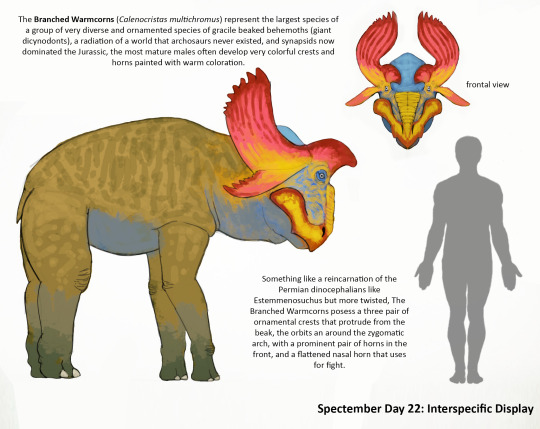
In the late Jurassic of north America, where titanic sauropods, ferocious theropods and a myriad of different dinosaurs should roam there I instead titanic dicynodonts and derived elephant sized Traversodontids wanders on the forests, hunted down by a variety of predatory Mammaliaforms and diverse cynodonts, and below many minor other synapsids and small new diapsids roams as middle size fauna, this world never saw any archosauromorphs rise as they became extinct in the Permian, leaving the Triassic and Jurassic to be fully dominated by the second wave of synapsids after the great dying and the minor constrains of an even weaker Triassic/Jurassic mass extinction.
With that and the time given it allowed some groups to diversify in ways they couldn’t have done in our timeline, specially for dicynodonts which apart of being the largest terrestrial animals here they also have been experimenting in other niches as aquatic herbivores, scavengers and even some small carnivores, and so many herbivores developing different fighting or extravagant ornaments in order to show their strength and good gene pool for any possible mate. This is where the Branched Warmcorns (Calenocristas multichromus) comes into play, coming from a lineage of more gracile forms than the usual beaked behemoth, they are around 2 meters long and they are the largest most flamboyant animals of the forestall regions, the young males and females are often dull colored with only a handful of prominent minor crests and horns, but an adult male in their peak would expose a series of very large ornamental crests and horns that bright in very warm colorations, including a variety of yellows, pinks, oranges and reds, all reflecting from a light blue face up to the back of the head. The bright adult has often to be dealing either with predators as well with other large males or just recently grown younger individuals that defy their domain over specific territories, normally with constant head ramming and even biting. They live in groups of 20 individuals, often a bull male is surrounded by different age females and just young individuals, which males reaching certain age have to leave before the main male could threat them or even kill them.
107 notes
·
View notes
Text
Spectember D21: Parasitism of any sort
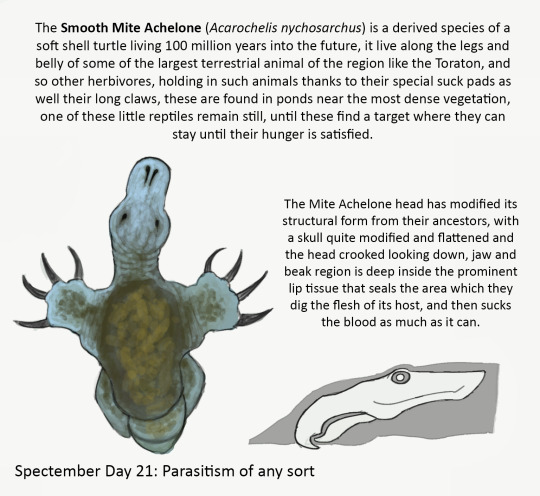
In 100 million years hence the Bengal swamp sort of host different new groups of animals, a lot happened since the mass extinction caused by a large asteroid at the beginning of the recovering period just 5 million years after the age of humanity, and since then it was a 0 for many groups, mammals barely are a diverse group anymore, with shrew like forms found in the rocky regions of the north and some other few minuscule species living along isolated continents, being now succeeded in diversity and megafauna with an amalgamation of squamates, birds and impressively turtles have taken the upper hand and became the dominant groups around the globe. The land is reign by the diverse descendants of softshell turtles, being many gigantic reaching on the leagues of sauropods, but at the same time in the other sides they diversified in many other niches like semiaquatic or even heavy land carnivores, some slow marine sirenian like forms, and from all the big and middle size some unique and strange small species adapted as a parasitic animal.
The Smooth Mite Achelone (Acarochelis nychosarchus) is among the smallest species of turtles alive reaching up 4 cm in length, when they are capable, they would attach to the giant behemoths that travel across the swamp, they properly do not look like any recognizable turtle species, instead they looks like disproportionately big headed critters with strange long and wide hands with extremely long claws, their jaws anatomy has distorted to accommodate its mouth on the bottom so they are always facing towards the skin, which with their strong derived lips they dig through the robust skin of their large hosts until they reach the blood vessels and start sucking blood and even lipids if they attach in the right spot. Their bodies are reduced, forelimbs are hypertrophied with disk like pads used to attach to their host along with their claws, up to the tail the cloaca seems to have elongated slightly, this due to the derivation of one of the rectal walls turned into a pseudo gill structure which provides of oxygen into the water, which is very useful when their large host stands for a good time into the deep rivers.
77 notes
·
View notes